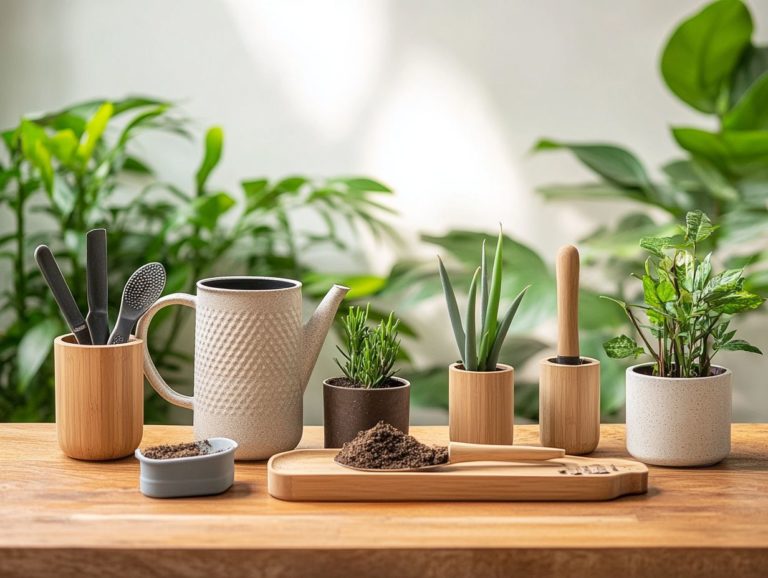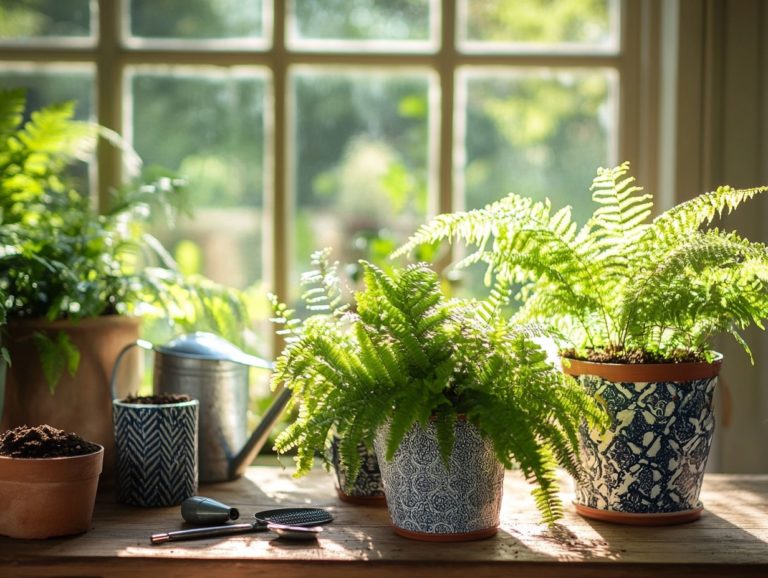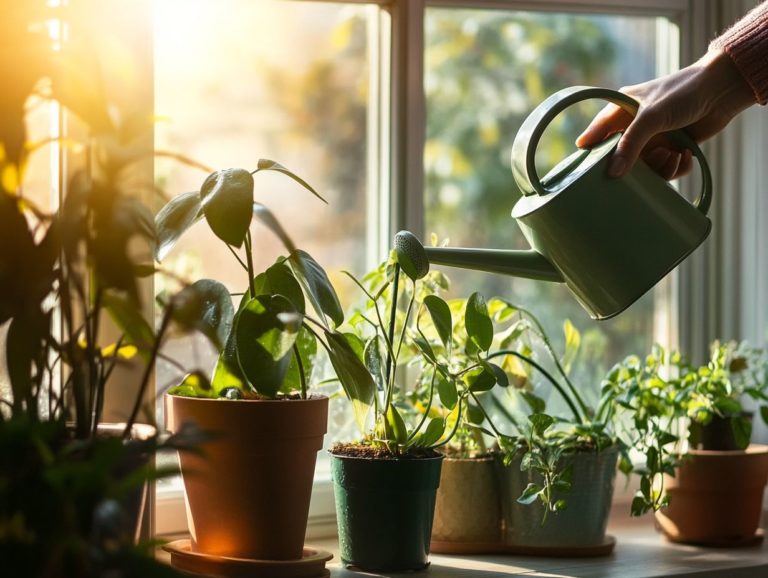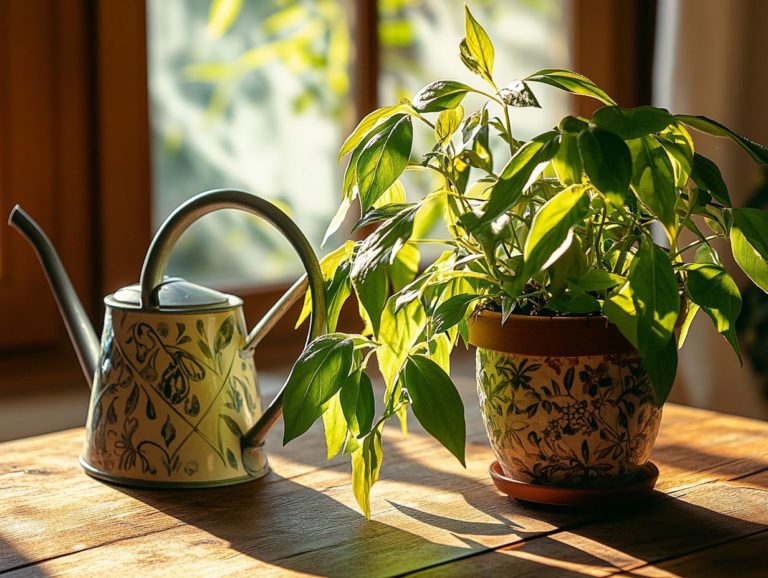What Indoor Plants Thrive in Low Light?
Indoor spaces can pose unique challenges for plant growth, especially in dark corners. Whether you find yourself in a cozy apartment or a home with limited natural light, the right selection of plants can transform your environment into a vibrant oasis.
This article delves into the factors that contribute to difficult environments for plant growth, explores the myriad benefits of indoor plants, and guides you on how to choose and care for easy-care varieties that flourish in such settings.
Discover how to optimize light and temperature to create the perfect atmosphere for your green companions. Prepare to breathe easier and uplift your mood with low-light indoor plants that thrive even where sunlight struggles to reach!
Contents
- Key Takeaways:
- Understanding Low Light Environments
- Benefits of Indoor Plants in Low Light
- Choosing the Right Plants for Low Light
- Caring for Indoor Plants in Low Light
- Creating the Ideal Low Light Environment
- Frequently Asked Questions
- What indoor plants thrive in low light?
- Are there any flowering plants that can survive in low light conditions?
- Can cacti and succulents grow in low light environments?
- Do indoor plants still need light if they are placed near a window?
- What are some other factors to consider when choosing indoor plants for low light environments?
- Can artificial light be used to supplement low light conditions for indoor plants?
Key Takeaways:
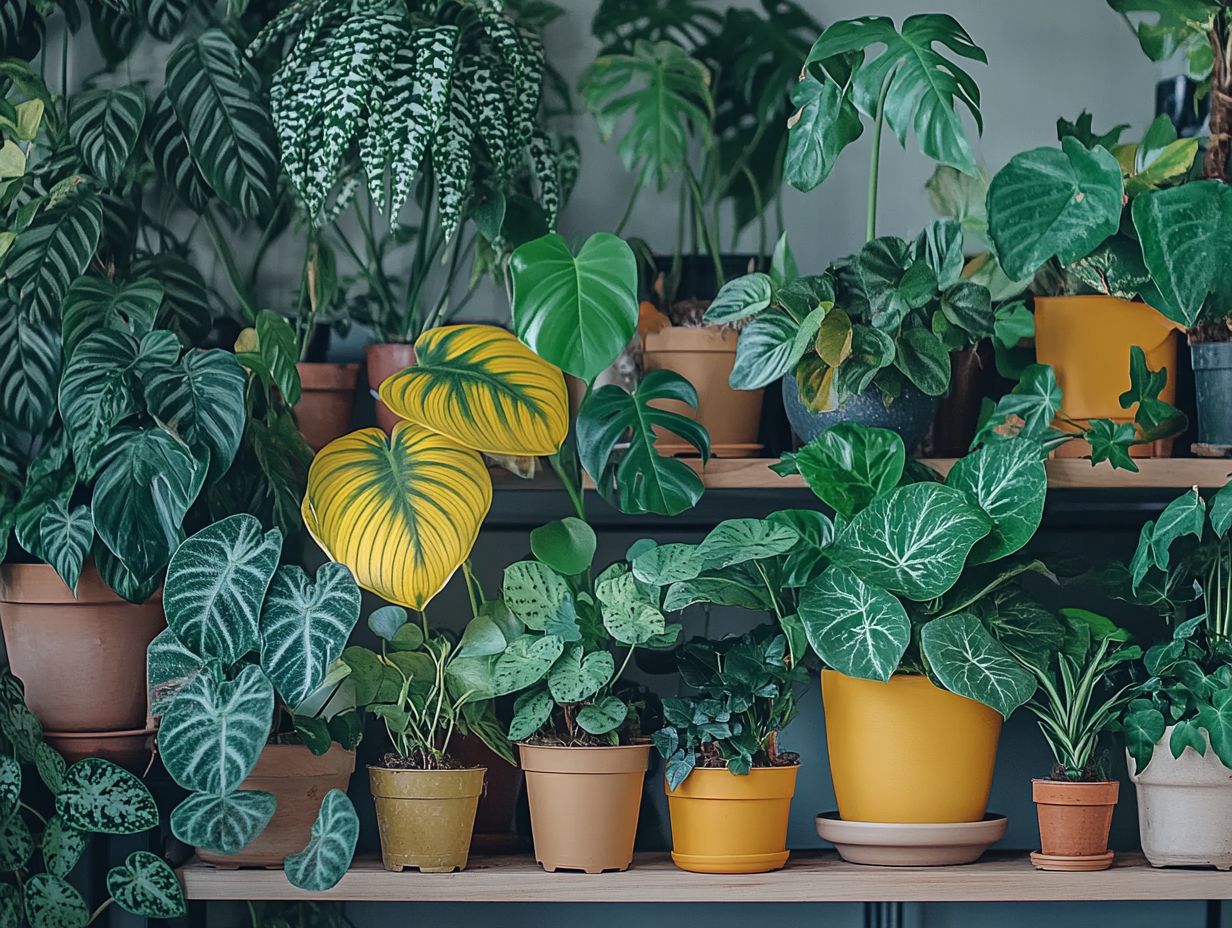
- Indoor plants can thrive in low-light environments, making them a great option for those with limited natural lighting. With expert-recommended species, you can ensure a beautiful collection.
- Plants in low light improve air quality and promote a positive mood, making them a beneficial addition to any indoor space. Don t forget their amazing ability to cleanse the air around you!
- Pick vibrant plants like pothos, snake plants, and peace lilies that thrive in low light, and provide proper care to ensure their growth and health.
Understanding Low Light Environments
Understanding low light environments is essential for your success in indoor gardening, particularly if your goal is to cultivate beautiful plants that thrive in such conditions. Many homes feature areas with low humidity and filtered light, which can be challenging for standard houseplants.
Select plant varieties that are best suited for low light and provide attentive care. If you’re unsure which plants to choose, consider exploring the best indoor plants for beginners. This approach can transform these spaces into nurturing environments, ensuring your indoor plants receive the light and moisture they need to flourish beautifully.
Factors that Contribute to Low Light
Several factors contribute to low light conditions in indoor spaces, such as the orientation of light-filtering windows, nearby buildings, and seasonal shifts that impact sunlight availability. These elements are crucial in determining whether your specific low-light plants can thrive indoors.
For plants that tolerate low light, understanding the importance of indirect light is essential. Typically, these plants thrive on indirect light, allowing them to photosynthesize effectively without the risk of being scorched by direct rays.
Maintaining the right humidity is vital; low humidity can stress your plants. Watch for signs like dry leaf edges or wilting. Act fast! Adjust your watering schedule to keep these plants thriving.
Benefits of Indoor Plants in Low Light
Indoor plants offer numerous benefits, even in low light. They improve air quality and elevate your mood while enhancing your home s aesthetics.
Incorporating these vibrant plants into your space creates a safe and inviting atmosphere. Their air-cleaning abilities significantly enhance both your physical and mental well-being. This harmonious blend of nature and design leads to a truly uplifting experience with your happy houseplant collection.
Improving Air Quality and Mood

Indoor plants serve as exceptional air purifiers, enhancing your air quality while uplifting your mood, even in low-light settings.
Among the many options available, the Peace Lily and Snake Plant truly shine in such environments. The Peace Lily not only adds a touch of elegance with its stunning white blooms, but it also excels at absorbing harmful pollutants like formaldehyde a toxic chemical found in many household products and benzene. It s a great choice for bedrooms and living areas.
The Snake Plant, with its striking upright leaves, plays a vital role in improving air quality by converting carbon dioxide into oxygen at night, significantly enhancing your sleep quality.
By incorporating these plants into your indoor spaces, you can enjoy fresh air and a calm atmosphere, ultimately fostering an improved mood and overall well-being. Don t wait transform your space with these vibrant plants today!
Choosing the Right Plants for Low Light
Selecting the right plants for low-light environments is crucial for your indoor gardening success. Not every houseplant can thrive in these conditions, so understanding this can make all the difference.
Experts recommend specific varieties that not only survive but genuinely flourish in low light. This ensures your home remains vibrant and beautifully alive.
Best Indoor Plants for Low Light Conditions
A selection of indoor plants thrives beautifully in low light, making them ideal companions for your space. Consider popular choices like the ZZ Plant, Snake Plant, and Pothos. Each requires minimal sunlight and adds a touch of elegance to your surroundings.
Take the ZZ Plant, for instance. With its glossy, dark green leaves, it practically flourishes on neglect, making it perfect for your busy lifestyle. This resilient plant thrives in indirect light and only needs watering every few weeks. If you’re curious about other options, check out the best indoor plants for low light, allowing you to focus on more important things.
The Snake Plant showcases striking vertical foliage that elevates your decor while purifying the air. It is wonderfully hardy and requires little more than occasional watering, effortlessly fitting into your routine.
Don t overlook Pothos, with its charming heart-shaped leaves. This vine adapts seamlessly to various lighting conditions, including low light. It prefers watering when the top inch of soil feels dry, promoting robust growth and allowing for stunning cascading displays.
Each of these plants enhances your indoor space while contributing to a healthier living environment.
Caring for Indoor Plants in Low Light
Caring for indoor plants in low light presents unique challenges, but with the right strategies, including simple plant care tips, you can ensure they thrive. Understanding the specific needs of these plants is crucial, especially when it comes to watering.
Follow these simple care tips to keep your plants healthy, thriving even in environments with limited sunlight.
Proper Watering and Maintenance Techniques
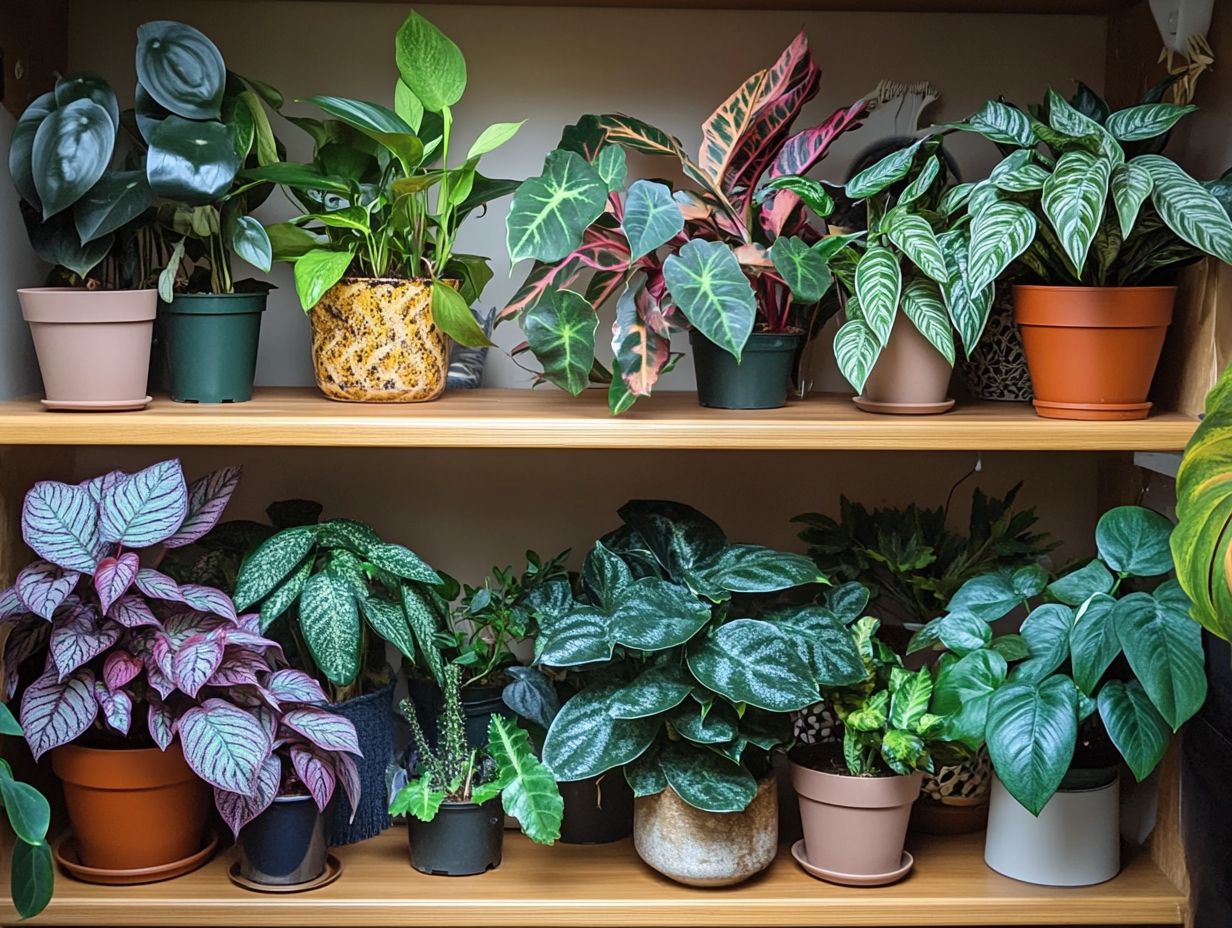
Understanding the proper watering requirements is essential for maintaining healthy indoor plants in low light. Overwatering can lead to root rot, which occurs when the roots sit in too much water, leading to decay. Underwatering can stress your beloved greenery, creating difficult environments for your plants.
To ensure that these easy care plants thrive, establish a consistent watering schedule tailored to their environment. Low-light houseplants typically require less frequent watering since the lack of sunlight slows their growth and reduces their water needs. If you’re looking for suggestions on the most resilient indoor plants, consider options that thrive in these conditions.
You can test the soil with your finger to see when it’s time to water. If the top inch feels dry, it’s likely time to hydrate. Using pots with drainage holes is smart, allowing excess moisture to escape and preventing over-saturation.
Wiping down the leaves regularly can enhance their ability to absorb any available light, ultimately boosting their overall health and ensuring your plant maintenance remains efficient.
Creating the Ideal Low Light Environment
Creating the perfect low-light environment for your indoor plants requires a delicate balance of light and temperature to ensure optimal growth. By understanding the unique conditions that low-light situations present, you can tailor your indoor gardening strategies to the specific needs of different plant varieties.
This thoughtful approach will help you cultivate a thriving indoor oasis that flourishes under your care.
Optimizing Light and Temperature for Plant Growth
To achieve optimal growth, you must adjust both light and temperature conditions for your indoor plants, particularly those that thrive in low-light environments.
By employing techniques such as grow lights, you can effectively mimic natural sunlight, delivering the essential spectrum needed for photosynthesis, which is the process that plants use to convert light into energy. This is particularly beneficial for **tropical plants** that may not receive enough light indoors.
Keeping an eye on indoor temperature is crucial; it should remain within the ideal range for various species, typically between 65 F and 75 F for most houseplants. Don t overlook humidity levels; using humidifiers or pebble trays can help create a balanced environment that nurtures plant health, especially for those indoor plants that prefer higher humidity.
Regularly rotating your plants for even light distribution is another strategy that enhances growth, leading to lush, vibrant greenery in any indoor setting, resulting in happy houseplants.
Frequently Asked Questions
What indoor plants thrive in low light?
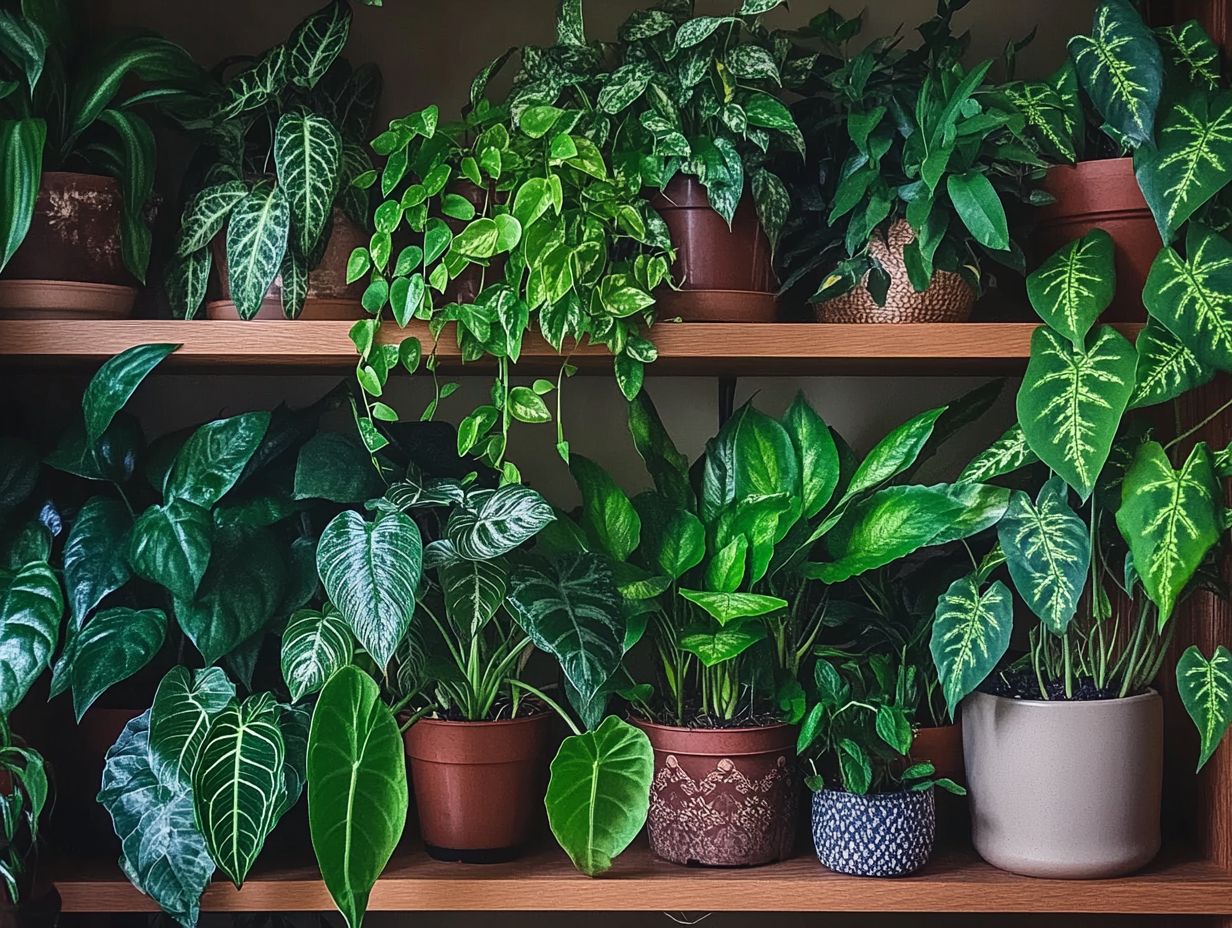
- Pothos
- Snake plant
- Peace lily
- ZZ plant
- Dracaena
- Spider plant
- Chinese evergreen
Are there any flowering plants that can survive in low light conditions?
Yes, a few flowering plants can thrive in low light, including African violets, begonias, and Gloxinia.
Can cacti and succulents grow in low light environments?
No, cacti and succulents are desert plants that require a lot of sunlight, so they typically do not thrive in low light conditions. For those areas, consider using faux plants.
Do indoor plants still need light if they are placed near a window?
Yes, even if placed near a window, indoor plants still need some level of light to survive and thrive. Ensure they receive enough light for their specific needs, especially for popular houseplants that thrive in low light.
What are some other factors to consider when choosing indoor plants for low light environments?
Consider low light tolerance, as well as the humidity and temperature levels in the room. The amount of care and maintenance required for the plant is also important. Exploring options like low-maintenance plants or tropical plants can help find the best fit for your needs.
Can artificial light be used to supplement low light conditions for indoor plants?
Yes, many types of artificial light can supplement low light conditions for indoor plants, including grow lights and fluorescent lights. It s essential to research and choose the right type of light for each specific plant’s needs, especially for low-light houseplants.
Remember, low-light plants still require care, proper humidity, and the right light for healthy growth! Start your indoor gardening adventure today!


